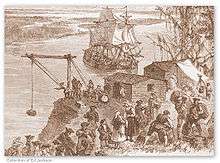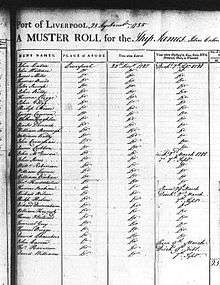James (ship)
The ship James made several trips during the early 17th century Great Migration out of England to the New World.[1] It is unclear how many ships were named James during the Great Migration, as the name James was very popular in England during the reign of James I of England (1567–1625).
1621-1622 voyage
From England to Virginia
It appears the James landed right around the New Year, because some of the passengers reported as landing in 1621, and others in 1622, most likely due to winter conditions. The first few off the ship were servants of Edward Bennett, the wealthy London merchant that had paid for over 800 servants to travel to the New World to work his plantations, and who had already established his plantation, so they had a place to stay.[2]
Passengers:
1621:
- William Bradford
- Wassell Webling, servant to Edward Bennett
- Antonio a Negro, servant to Edward Bennett
1622:
Isack Chaplaine arrived in Virginia in 1610 aboard the Starr and then sent for his family ten years later, as they arrived on the James:
- Mary Chaplaine, wife of Isack Chaplaine
- John Chaplaine, age 15, son of Isack Chaplaine
- John Duffhill, age 14, servant for Isack Chaplaine
- Robert Hudson, age 30, servant for Isack Chaplaine
- Henry Thorne age 18, servant for Isack Chaplaine
- Ivy Banton, maid for Isack Chaplaine
The other passengers include;
- Grivell Pooley, minister
- John Bamford, age 23, servant for Abraham Peirsey
- Richard English, servant for Thomas Palmer, who arrived months earlier on the Tyger
- Richard Appleton, age 19, one of William Tucker's men
- Lawrence Evans, age 15, servant for Nathaniel Cawsey, who arrived on the Phoenix in 1607
- William Popleton, servant for John Davies, who arrived on the George in 1617
- Nicholas Sutton, dead at Chaplans Choise, slain by Indians 1624
- Anthony West (1606-1654), hired for Treasurers Plantation
1624 voyage
James left Bermuda with master Toby Ffolgate at the helm, and arrived in Virginia.[3]
| The information below (1633) is not correct. Captain Wiggin was not "at the helm" of the James. Wiggin did not "command an earlier expedition to this area". He came in 1630 as an agent for the Bristol Merchants and then in 1633 for the two Lords and a group of men collectively called "Shrewsbury Merchants" along with William Whiting and Willis who had shares in the venture. William Whiting came in 1633 on the James with Capt. Wiggin and his second wife, Catherine Whiting, sister to William Whiting. |
1633 voyage
James left Gravesend, England, with master Captain Thomas Wiggin at the helm, and arrived in Salem, Massachusetts on October 10, 1633. The James was described as a relatively small but sturdy ship, carrying 100 Pilgrims along with horses, cattle, goats and provisions landed at Salem on October 10, 1633. After disembarking, Captain Wiggin and 30 others sailed further up the coast to Hilton Point, what is now known as Dover, New Hampshire, and started a new settlement. Wiggin, a strict Puritan, commanded one of the early explorations to New Hampshire during this period and was appointed by English entrepreneurs to make land acquisitions and organize potential settlers.[4]
1635 voyages
The ship James of London sailed from Southampton on April 5, 1635 and arrived in Massachusetts Bay on June 3,[5] 1635 with master William Cooper at the helm.
The ship James left King's Road in Bristol on May 23, 1635 with master John Taylor at the helm. From England to Massachusetts in a fleet of five ships, the Angel Gabriel, the Elizabeth and Ann (Bess), the Mary and the Diligence.
On June 3, 1635, the James joined four other ships, and set sail for the New World with just over 100 passengers as part of a fleet of five ships, including the families of Richard Mather, Captain John Evered, John Greene and John Ayer. As they approached New England, a hurricane struck and they were forced to ride it out just off the coast of modern-day Hampton, New Hampshire. According to the ship's log and the journal of Increase Mather, whose father Richard Mather and family were passengers, the following was recorded;
"At this moment,... their lives were given up for lost; but then, in an instant of time, God turned the wind about, which carried them from the rocks of death before their eyes. ...her sails rent in sunder, and split in pieces, as if they had been rotten ragges..."
They tried to stand down during the storm just outside the Isles of Shoals, but lost all three anchors, as no canvas or rope would hold, but on Aug 13, 1635, torn to pieces, and not one death, all one hundred plus passengers the James manages to make it to Boston Harbor two days later.
The Angel Gabriel was wrecked off the coast of Maine, but the smaller, faster ships, the Mary, the Bess, and the Diligence outran the storm, and landed in Newfoundland on August 15, 1635.[1]
1662 voyage
The James left Bermuda on August 5, 1662 with Captain William Sayle and James Sayle under the command of Matthew Normal in search of Eleutheria.[6]
1733 voyage

According to Georgian History, the James was the first ship to be unloaded at Savannah.[7]
1787-1789 voyage

On December 22, 1787, James under Captain John Canton from Liverpool to Jamaica as a cargo ship, arriving February 9, 1788. They unloaded the beef, and loaded up with the sugar cargo bound for Charleston, North Carolina. They arrived in Charleston unloaded, then reloaded with cotton bound back to Liverpool on September 7, 1788.[8]
Just three months later, on December 16, 1788, under Captain Thomas Wilks embarked on the same cargo trip, arriving back in Liverpool on July 24, 1789.[8]
Other ship James
- Ship James Goodwill, 1727 from Rotterdam via Portsmouth to Philadelphia
- Ship James Wright, 1851 from Liverpool to New York
- Ship James Baines (clipper), 1854 British Navy
- Ship James Fernie, 1854 from Liverpool to Port Adelaide
- Ship James Jardine (ship), 1859 from Plymouth to Port Adelaide
- Ship James Foster Jr., 1868 from Liverpool to New York
References
- Anne, Lady. "Pilgrim Ship Lists By Date".
- article "Edward Bennett of London and Virginia" by John Bennett Boddie "The William and Mary Quarterly, Second Series, Vol. 13, No. 2" (Apr., 1933), pp. 117-130. Published by: Omohundro Institute of Early American History and Culture
- "Google Image Result for rootsweb.ancestry.com/~bmuwgw/seaventure.jpg".
- Park, Arthur's Park , Arthur's Park , Arthur's (3 January 2012). "AHV and ADV at their Maine Hunting Retreat".
- Banks, Charles Edward (1961). The Planters of the Commonwealth. Baltimore: Genealogical Publishing Co. pp. 135–136.
- "MEMORIALS OF THE BERMUDAS; Memorials of the Discovery and Early Settlement of the Bermudas or Somers Islands 1515-1685" by JOHN HENRY LEFROY
- http://georgiainfo.galileo.usg.edu/tdgh-may/may14.htm
- Bob (23 June 2009). "Cannundrums: Ship James: Two Voyages (1787 to 1789)".